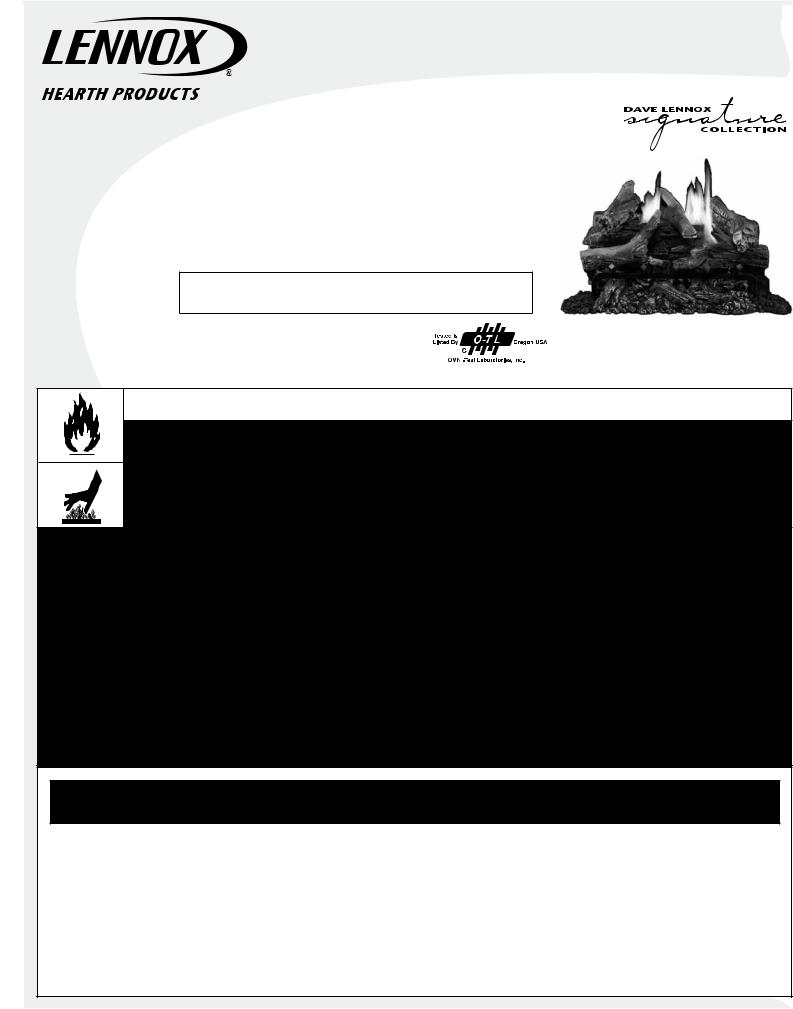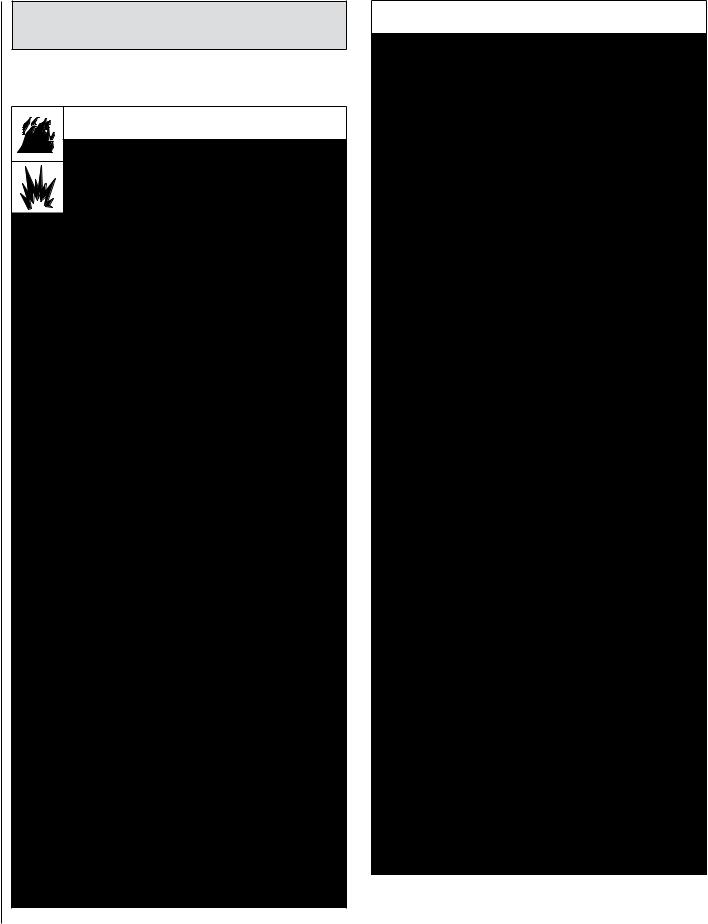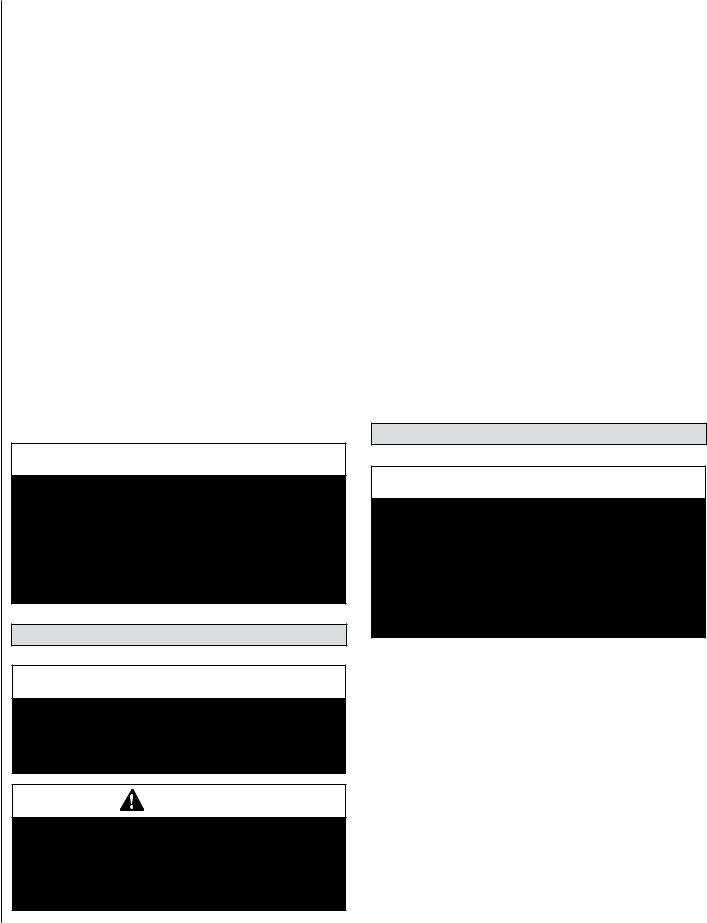Lennox LSVFSD-18, LSVFSD-NG, LSVFSD-24, LSVFSD-30, LSVFSD-LP User Manual

INSTALLATION AND OPERATION INSTRUCTIONS
Vent-Free Millivolt
Dual-Listed Gas Log Sets
Gas Train Models: |
Log Set Models: |
LSVFSD-NG |
LSVFSD-18 Logs |
LSVFSD-LP |
LSVFSD-24 Logs |
Log Sets Sold Separately |
LSVFSD-30 Logs |
P/N 850051M Rev. C, 03/2011
Installer: Leave This Manual With The Appliance. Consumer: Retain This Manual For Future Reference.
TM
In the Commonwealth of Massachusetts: |
|
|
Portland |
|
•Installationmustbeperformedbyalicensedplumberorgasfitter |
|
US |
Shadowdance™ Series |
|
• See Table of Contents for location of additional |
|
|||
|
|
|
||
Commonwealth of Massachusetts requirements |
|
|
|
|
|
|
|
|
|
Report No.116-L-49-5 |
|
|||
 WARNINGS
WARNINGS
•Hot! Do not touch! This appliance will be hot during operation and will retain heat for a while after shutting off the appliance. Severe burns may result.
•Carefully supervise children in the same room as appliance.
•Improper installation, adjustment, alteration, service or maintenance can cause injury or property damage. Refer to this manual. For assistance or additional information consult a qualified installer,
service agency or the gas supplier.
•Do not build a wood fire. Do not burn wood or other material in these appliances.
•Carefully review the instructions supplied with the decorative type unvented room heater for the minimum fireplace size requirement. Do not install the appliance in the fireplace, unless the fireplace meets the minimum dimensions required for the installations (see Page 3).
•This is an unvented gas log appliance. It uses air (oxygen) from the room in which it is installed. Provisions for adequate combustion and ventilation air must be provided. Refer to Combustion and Ventilation Air Section on Page 5.
•Important: Read and understand these instructions completely before installing your unvented room heaters.
•This appliance is only for use with the type of gas indicated on the rating plate. This appliance is not convertible for use with other gases. If the gas supply differs, DO NOT INSTALL the appliance. Contact your dealer to obtain the correct appliance.
•This appliance may be installed in an aftermarket, permanently located, manufactured (mobile) home, where not prohibited by local codes.
•Lennox® vent-free gas logs are designed for use as a supplemental heater. They are not intended for continuous use as a primary heat source.
WARNING: If the information in this manual is not followed exactly, a fire or explosion may result causing property damage, personal injury or loss of life.
Do not store or use gasoline or other flammable vapors and liquids in the vicinity of this or any other appliance.
WHAT TO DO IF YOU SMELL GAS:
•Do not light any appliance.
•Do not touch any electrical switch; do not use any phone in your building.
•Immediately call your gas supplier from a neighbor’s phone. Follow your gas supplier's instructions.
•If your gas supplier cannot be reached, call the fire department.
Installation and service must be performed by a qualified installer, service agency or the gas supplier.

IMPORTANT SAFETY AND WARNING INFORMATION
read THIS MANUAL IN ITS ENTIRETY and understand these Rules to follow for safety.
 WARNINGS
WARNINGS
If the information in this manual is not followed exactly, a fire or explosion may result causing property damage, personal injury or loss of life.
•Children and adults should be alerted to the hazard of high surface temperature and should stay away to avoid burns or clothing ignition.
•Do not place clothing or other materials on or near the heater.
•Young children should be carefully supervised when they are in the same room with the appliance.
•Due to high temperatures, the appliance should be located out of traffic and away from furniture and draperies.
•Any change to this heater or its operating controls can be dangerous. Improper installation or use of this appliance can cause serious injury or death from fire, burns, explosion or carbon monoxide poisoning.
•Carbon Monoxide Poisoning: Early signs of carbon monoxide poisoning are similar to the flu with headaches, dizziness and/or nausea. If you have these signs, obtain fresh air immediately. Have the VentFree Gas Heater serviced by a qualified technician as it may not be operating correctly. Some people are more affected by carbon monoxide than others. These include pregnant women, people with heart or lung disease or anemia, those under the influence of alcohol, and those at high altitudes.
•Any safety screen or guard removed for servicing an appliance must be replaced and/or closed prior to operating the heater.
•Installation and repair should be done by a qualified service person. The appliance should be inspected before use and at least annually by a professional service person. More frequent cleaning may be required duetoexcessivelintfromcarpeting,beddingmaterial, etc. It is important that control compartments, burners and circulating air passageways of the appliance be kept clean.
•This appliance is for installation only in a solid-fuel burning masonry or UL 127 factory-built fireplace or in a listed ventless firebox enclosure. It has been design certified for these installations. Exception: DO NOT install this appliance in a factory-built fireplace that includes instructions stating it has not been tested or should not be used with unvented gas logs.
2
 WARNINGS
WARNINGS
•Allow the appliance to cool before servicing. Always shut off any electricity or gas to the appliance while performing service work.
•The appliance and its individual shut-off valve must be disconnected from the gas supply piping system while performing any tests of the gas supply piping system at test pressures equal to or less than 1/2 psig.
•Thisappliancemustnotbeoperatedwithoutafireplace screen installed. Fireplace screens must not impair the free flow of combustion air to the appliance.
•Failure to comply with the installation and operation instructions provided in this document will result in an improperly installed and operating appliance, voiding its warranty.
•The appliance must be isolated from the gas supply piping system by closing its individual manual shut-off valve during any pressure testing of the gas supply piping system at test pressures equal to or less than 1/2 psig.
•Keep heater area clear and free from combustible materials, gasoline and other flammable vapors and liquids.
•Do not use this room heater if any part has been under water. Immediately call a qualified service technician to inspect the room heater and to replace any part of the control and any gas control which has been under water.
•Ensure that the appliance is clean when operating. Excessive dust accumulation on the burner and/or logs will increase the amount of carbon monoxide formation and could lead to the formation of soot, carbon monoxide poisoning and sickness or death.
•Maintain minimum clearances.
•Do not burn solid fuels in any fireplace equipped with this gas appliance.
•Do not allow fans to blow directly into the fireplace. Avoid any drafts that alter burner flame patterns.
•Do not install the appliance in a sleeping room or bathroom.
•The installation must conform with local codes or, in the absence of local codes, with the National Fuel gas Code, ANSI Z223.1/NFPA 54-latest edition.
•Input ratings are shown in BTU per hour and are for elevations up to 4500 feet. When installing any vent-free appliance at elevations above 4500 feet, nuisance pilot outages may occur.
•This appliance is intended for supplemental heating.

CONGRATULATIONS!
When you purchased your new gas log heaters, you joined the ranks of thousands of individuals whose answer to their home heating needs reflects their concern for aesthetics, efficiency and our environment. We extend our continued support to help you achieve the maximum benefit and enjoyment available from your new gas log heaters.
Thank you for selecting a Lennox Hearth Products gas log heaters as the answer to your home heating needs.
TABLE OF CONTENTS |
|
|
Important Safety Information.................................................... |
Page |
2 |
Packaging List........................................................................... |
Page |
3 |
General Information................................................................... |
Page |
3 |
Tools Required........................................................................... |
Page |
4 |
Burn-In Period........................................................................... |
Page |
4 |
Codes........................................................................................ |
Page |
4 |
New Your City (MEA) Approval.................................................. |
Page |
5 |
Requirements for the |
|
|
Commonwealth of Massachusetts.......................................... |
Page |
5 |
Combustion and Ventilation Air................................................. |
Page |
5 |
Pre installation........................................................................... |
Page |
6 |
Clearances................................................................................. |
Page |
6 |
Installation................................................................................. |
Page |
8 |
Gas Pressure Check................................................................... |
Page |
9 |
Log Placement Instructions....................................................... |
Page10 |
|
Pilot Flame Appearance............................................................. |
Page12 |
|
Burner Flame Appearance.......................................................... |
Page12 |
|
Operation and Care.................................................................... |
Page13 |
|
Cleaning and Servicing.............................................................. |
Page13 |
|
Replacement Parts Instructions................................................. |
Page13 |
|
Accessories............................................................................... |
Page14 |
|
Millivolt Wiring Diagram............................................................ |
Page16 |
|
Appliance Specification Chart.................................................... |
Page16 |
|
Operating Instructions – Millivolt............................................... |
Page17 |
|
Troubleshooting Guide............................................................... |
Page18 |
|
Replacement Parts List – Millivolt............................................. |
Page19 |
|
This installation manual will help you obtain a safe, efficient, dependable installation for your appliance.
PLEASE READ AND UNDERSTAND THESE INSTRUCTIONS
BEFORE BEGINNING YOUR INSTALLATION
PACKAGING LIST
The gas train models LSVFSD-NG and LSVFSD-LP are packaged with the following:
1 - One base/grate assembly
2 - One bag of lava rock
3 - One damper clamp
4 - One literature package, which consists of the installation and operation manual and warranty
Log sets are sold separately (see Page 15 for ordering information)
INTRODUCTION
These Gas Log Appliances incorporate unitized ceramic fiber logs which provides some glow realistically when the appliance is operating.
The gas log sets covered in this document are heater rated units. These units are equipped with a millivolt gas valve. The control knob is set to the desired position, which maintains a continuous gas burning rate.
A spark ignition system (piezo) allows the gas pilot to be lit without the use of matches or batteries and permits operation of the heater during a power outage.
GENERAL INFORMATION
These Dual-Listed Gas Log Appliances are equipped with a specially designed pilot utilizing an oxygen depletion sensor (ODS) which responds to the amount of oxygen available in the room and shuts the heater off before the oxygen level drops below 18%. The pilot can be relit only when fresh air is available. Refer to the Combustion and Ventilation Air section.
These appliances are approved to be installed into an existing masonry fireplace (built to UBC Chapter 37, Masonry Standards) or factory built solid fuel, wood burning fireplace (listed to UL 127, Factory Built Fireplace Standards) or a built-in Vent-Free Firebox (listed to Ventless Firebox Enclosures for Gas-Fired Unvented Decorative Room Heaters to ANSI Z21.91). Any outside air ducts and/or ash dumps in the fireplace shall be permanently closed at time of appliance installation. See Figure 1 for the minimum size requirements of the existing firebox.
See Figure 1 for the minimum size requirements of the existing firebox in which the gas logs will be installed.
Log Set |
Height |
|
Depth |
Width Front |
|
Width Rear |
|
|||||||||||||||||||
|
(A) |
|
(B) |
|
|
(C) |
|
|
(D) |
|
||||||||||||||||
|
|
|
|
|
|
|
|
|
|
|
|
|
|
|
|
|
|
|
|
|
||||||
LSVFSD-18 Logs |
19" |
|
|
14" |
|
30" |
|
|
|
20-1/2" |
|
|
||||||||||||||
|
|
|
|
|
|
|
|
|
|
|
|
|
|
|
|
|
|
|
|
|
||||||
LSVFSD-24 Logs |
19" |
|
|
14" |
|
30" |
|
|
|
24-1/2" |
|
|
||||||||||||||
|
|
|
|
|
|
|
|
|
|
|
|
|
|
|
|
|
|
|
|
|
||||||
LSVFSD-30 Logs |
19" |
|
|
14" |
|
38" |
|
|
|
24-1/2" |
|
|
||||||||||||||
|
|
|
|
|
|
|
|
|
|
|
|
|
|
|
|
|
|
|
|
|
|
|
|
|
|
|
Side View |
|
|
|
|
|
|
|
|
|
|
|
Top View |
|
|
|
|
|
|
|
|
|
|||||
|
|
|
|
|
|
|
|
|
|
|
|
|
|
|
|
|
|
|
|
|
|
|
|
|
|
|
|
|
|
|
|
|
|
|
|
|
|
|
|
|
|
|
|
|
|
|
|
|
|
|
|
|
|
|
|
|
|
|
|
|
|
|
|
|
|
|
|
|
|
|
|
|
|
|
|
|
|
|
||
|
|
|
|
|
|
|
|
|
|
|
|
|
D |
|
|
|
|
|
|
|
|
|
|
|
|
|
|
|
|
|
|
|
|
|
|
|
|
|
|
|
|
|
|
|
|
|
|
|
|
||||
|
|
|
|
|
|
|
|
|
|
|
|
|
|
|
|
|
|
|
|
|
|
|
|
|
|
|
|
|
|
A |
|
|
|
|
|
|
|
|
|
|
|
|
|
|
|
|
|
|
B |
|
|
||
|
|
|
|
|
|
|
|
|
|
|
|
|
|
|
|
|
|
|
|
|
|
|
|
|
|
|
|
|
|
|
|
|
|
|
|
|
|
|
|
|
|
|
|
|
|
|
|
|
|
|
|
|
|
|
|
|
|
|
|
|
|
|
|
|
|
|
|
|
|
|
|
|
|
|
|
|
|
|
|
|
|
|
|
|
|
|
|
|
|
|
|
|
|
|
C |
|
|
|
|
|
|
|
|
|
|
|
|
|
|
|
|
|
|
|
|
|
|
|
|
|
|
|
|
|
|
|
|
|
|
|
|
|
|
|
Figure 1 - Minimum Fireplace (Firebox) Size
Note: Diagrams AND illustrations ARE not to scale. |
3 |

SEE TABLE 3 ON PAGE 16 FOR BTU INPUT AND GAS PRESSURE REQUIREMENTS
Do not install these Dual-Listed Gas Log Appliances in a bedroom or a bathroom as all units exceed maximum allowable BTU/hr input of 10,000.
Tools and Supplies Normally Required
External regulator (Propane models only)
Manual shut-off valve
Sediment trap
Piping complying with local codes
Pipe compound
Pipe wrench
Tee joint
Screwdriver
Burn-in Period
During the first few times of operation of this appliance there will be some odor due to the curing of the paint and burning off of lubricants used in the manufacturing process. We recommend that you open windows and ventilate the house during the initial burns. The paint emits non-toxic odors during this process.
Depending on your use, the burn-in period may take a few hours or a few days. Also if you have a sensitive sense of smell you may notice slight odors during operating after the burn-in period is over.
KEEP YOUR HOUSE WELL VENTILATED DURING THE BURN-IN PERIOD. THE ODOR AND HAZE EMITTED DURING THE BURN-IN PERIOD CAN BE QUITE NOTICEABLE AND MAY SET OFF A SMOKE DETECTOR. MAKE SURE SMOKE DETECTORS ARE NOT TOO CLOSE TO THE FIREBOX (CHECK WITH YOUR LOCAL CODE FOR ALLOWABLE DISTANCES).
4
CODES
Adhere to all local codes or in their absence the latest edition of The National Fuel Gas Code ANSI Z223.1 or NFPA 54-latest edition which can be obtained from The American National Standards Institute, Inc. (1430 Broadway, New York, NY, 10018) or National Fire Protection Association, Inc. (Batterymarch Park, Quincy, MA, 02269).
State or local codes may only allow operation of this appliance in a vented configuration. Check your state or local codes.
Seller of unvented propane or natural gas-fired supplemental room heaters shall provide to each purchaser a copy of 527 CMR 30 upon sale of the unit (This is a standard Unvented Propane or Natural GasFired Space Heaters).
Shadowdance™ Gas Log appliances are certified by OMNI-Test Laboratories to ANSI Z21.11.2 unvented room heaters standard. These gas log appliances may be used as a space heat source for a room in conjunction with an approved unvented firebox.
Additionally, these units are design certified by OMNI-Test Laboratories to ANSI 21.60 / CSA 2.26 Decorative Appliance. For installation in solidfuel burning fireplaces.
As such, these units may be used as a vented gas log set in any woodburning fireplace that has been properly constructed to code, and in the case of factory built fireplaces, installed in compliance with manufacturers listing and installation instruction.
Use of the log sets covered by this manual in a properly vented woodburning fireplace which has had the damper blocked open as detailed below, preclude consideration of the combustion and ventilation air and clearance to combustible restrictions discussed herein.
When local codes require the damper to be fixed open, a damper stop must be installed to prevent full closure of the fireplace damper and provide a minimum 29 square inch flue opening at all times.
This appliance is for installation in a solid fuel burning fireplace (masonry fireplace or manufactured fireplace) with a working flue and constructed of noncombustible material.
The minimum permanent free opening of the fireplace chimney or chimney damper must be at least 29 sq. inches based upon a minimum chimney height of at least 15 feet. Chimney damper must be fixed in a manner to maintain permanent free opening at all times.

New York
Installation of these gas log heaters are approved in the state of New York and are prohibited in New York City.
Massachusetts Requirements
These fireplaces are approved for installation in the US state of Massachusetts if the following additional requirements are met:
•Unvented Room Heaters shall be installed in accordance with 527 CMR 30.00 and 248 CMR 3.00 through 7.00:
•Installation and repair must be done by a plumber or gas fitter licensed in the Commonwealth of Massachusetts
•The flexible gas line connector used shall not exceed 36 inches (92 centimeters) in length.
•The individual manual shut-off must be a T-handle type valve.
•Vent-Free appliances may NOT be installed in bedrooms or bathrooms.
•A working smoke detector must be installed in the area where ventfree appliances are installed.
Seller of unvented propane or natural gas-fired supplemental room heaters shall provide to each purchaser a copy of 527 CMR 30 upon sale of the unit.
Combustion and Ventilation Air
This heater shall not be installed in a confined space or unusually tight construction unless provisions are provided for adequate combustion and ventilation air. The heater may be located in unusually tight construction provided the space is unconfined, or if confined, is provided with two permanent openings communicating directly with an additional room(s) of sufficient volume so that the combined volume of all connected spaces meets the criteria for an unconfined space, (National Fuel Gas Code NFPA 54 / ANSI Z223.1 (latest edition), Section on Air for Combustion and Ventilation. Generally 50 ft 3 per 1,000 BTU input of all operating appliances in the space.
The National Fuel Gas Code, ANSI Z223.1/NFPA 54-latest edition defines a confined space as a space whose volume is less than 50 cubic feet per 1000 Btu per hour (4.8 m³ per kW) of the aggregate input rating of all appliances installed in that space and an unconfined space as a space whose volume is not less than 50 cubic feet per 1000 Btu per hour (4.8 m³ per kW) of the aggregate input rating of all appliances installed in that space.
Rooms communicating directly with the space in which the appliances are installed, through openings not furnished with doors, are considered a part of the unconfined space.
Unusually tight construction is defined as construction where:
a.Wall and ceilings exposed to the outside atmosphere have a continuous water vapor retarder with a rating or one perm (6 x 10-11 kg per pa-sec-m2) or less with openings gasketed or sealed;
b.Weather stripping has been added on operable windows and doors; and
c.Caulking or sealants are applied to areas such as joints around window and door frames, between sole plates and floors, between wall-ceiling joints, between wall panels, at penetrations for plumbing, electrical, and gas lines, and at other openings.
Use the following equations to determine if you have a confined or unconfined space.
1.Determine the volume of space — ft 3. Length x Width x Height = ______ ft 3
(Include adjoining rooms with doorless passageways or ventilation grills between rooms).
Example: 24' (L) x 16' (W) x 8' (H) = 3072 ft 3
2.Divide the volume of space by 50 ft 3 to determine the maximum BTU/Hr the space can support.
(volume of space – ft 3) / 50 ft 3 = (Maximum BTU/Hr the space can support)
Example: 3072 ft 3 / 50 ft 3 = 61.44
or 61,440 BTU/Hr the space can support.
3.Add the BTU/Hr of all the fuel burning appliances in the space.
Vent-Free Heater |
________ |
BTU/Hr |
Gas Appliance #1* |
________ |
BTU/Hr |
Gas Appliance #2 |
+________ |
BTU/Hr |
total =________ |
BTU/Hr |
|
Example: |
|
|
Vent-Free Heater |
36,000 |
BTU/Hr |
Gas Appliance #1 |
35,000 |
BTU/Hr |
(water heater) |
|
|
total = 71,000 |
BTU/Hr |
|
* Do not include Direct-Vent Gas Appliances. Direct-Vent is sealed combustion and draws combustion air from the outdoors.
5

4. Compare the maximum BTU/Hr the space can support with the actual amount of BTU/Hr used.
__________ |
BTU/Hr |
|
(max. the space can support) |
__________ |
BTU/Hr |
|
(actual amount of BTU/Hr used) |
Example: |
|
61,440 |
BTU/Hr |
|
(max. the space can support) |
71,000 |
BTU/Hr |
|
(actual amount of BTU/Hr used) |
The space in the above example is a confined space because the actual BTU/Hr used is more than the maximum BTU/Hr the space can support. You must provide additional fresh air.
Your options are:
a.Rework equations adding the space of adjoining room(s). If the extra volume provides an unconfined space, then remove door or add ventilation grills between rooms. Refer to National Fuel Gas Code, ANSI Z223.1 - latest edition, Section on Air for Combustion and Ventilation.
b.Vent room directly to the outdoors. Refer to National Fuel Gas Code, ANSI Z223.1 - latest edition, Section on Air for Combustion and Ventilation.
c.Install a lower BTU/Hr appliance, such as a 24,000 BTU/Hr, to make the area an unconfined space.
If the actual BTU/Hr used is less than the maximum BTU/Hr the space can support, then the space is an unconfined space. You will need no additional fresh air ventilation for an unconfined space.
 WARNING
WARNING
If the area in which the heater may be operated is smaller than that defined as an unconfined space or if the building is of unusually tight construction, you must provide adequate combustion and ventilation air by one of the methods described in the National Fuel Gas Code, ANSI Z223.1, Section on Air for Combustion and Ventilation or applicable local codes.
Preinstallation
 WARNING
WARNING
Before installing in a solid fuel burning fireplace, the chimney flue and firebox must be cleaned of soot, creosote, ashes and loose paint by a qualified chimney cleaner.
CAUTION
Appliances create warm air currents. These currents move heat to wall surfaces next to appliance. Installing appliance next to vinyl or cloth wall coverings or operating appliance where impurities in the air (such as tobacco smoke) exists, may discolor walls.
6
Note: Illustrations shown in this manual reflect “typical” installations with nominal dimensions and are for reference only. Actual installations may vary due to individual design preferences. However, always maintain minimum clearances to combustible materials and do not violate any specific installation requirements. Refer to Figures 2 through 8 for clearances.
Note: The following steps represent the normal sequence of installation. Each installation is unique, however, and might require a different sequence.
•Turn off gas supply to the fireplace or firebox.
•Position appliance in fireplace or firebox.
•Connect gas line.
•Secure appliance.
•Operate the appliance and check operation.
•Maintain adequate clearances for accessibility for purposes of servicing and proper operation.
•Minimum clearances include any projections such as shelves, window sills, mantels, spacers/standoffs or surfaces to combustible construction etc. above the appliance. Paint or lacquer used to finish the mantel must be heat resistant in order to avoid discoloration.
Check Gas Type
This appliance can only be connected to the gas type specified on the appliance rating plate. This appliance can not be modified in the field for a different gas type. If the gas supply differs, DO NOT INSTALL the appliance. Contact your dealer to obtain the correct appliance.
Clearances
 WARNING
WARNING
Do not install this gas appliance:
•In sleeping quarters, bathrooms, or a recreational vehicle.
•Where curtains, furniture, clothing or other flammable objects are less than 42" from the front of the gas appliance.
•In high traffic areas.
•In windy or drafty areas.
Vent free applications
WHEN INSTALLED IN A VENT-FREE FIREBOX, IF THE CLEARANCES SHOWN ON PAGES 7 & 8 OF THIS MANUAL ARE GREATER THAN THE CLEARANCES FOR THE VENT-FREE FIREBOX, THE LESSER CLEARANCES OF THE VENT-FREE FIREBOX APPLY.
Ensure the minimum clearances shown in Figures 2 through 8 are maintained. Left and right clearances are determined when facing the front of the appliance.
Follow these instructions carefully to ensure safe installation. Failure to follow these requirements may create a fire hazard.
Step 1. Sidewall Clearances: The sides of the fireplace opening must be at least 16" from any combustible side wall (Figure 2).
